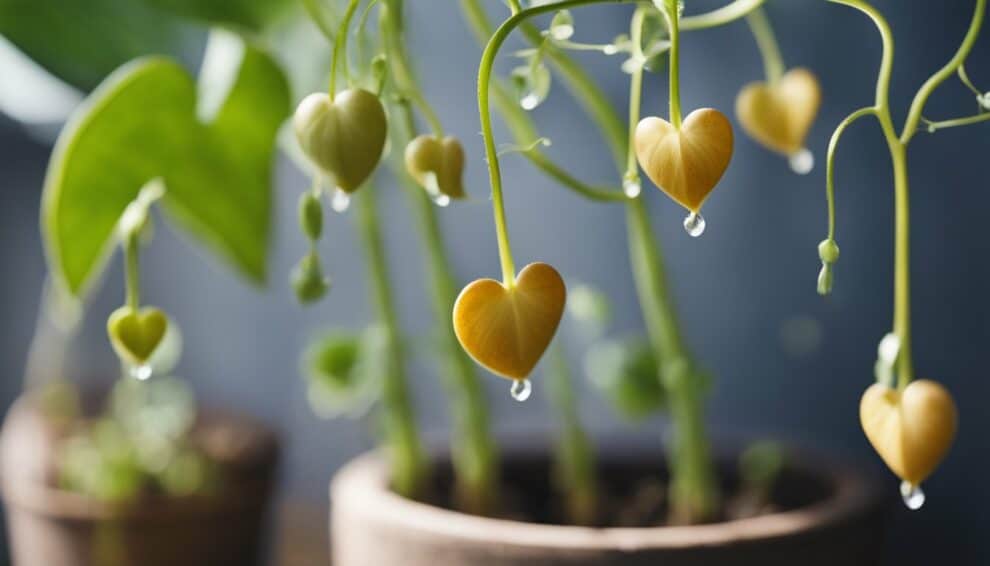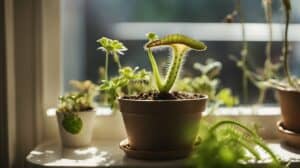Ceropegia Woodii, commonly known as String of Hearts, is a popular trailing plant that is native to South Africa.
Its delicate heart-shaped leaves and long vines make it a favorite among plant enthusiasts.
Propagating String of Hearts is a fun and rewarding way to expand your plant collection, and it’s easier than you might think.

One of the most common ways to propagate String of Hearts is through stem cuttings.
This involves taking a cutting from the parent plant and rooting it in water or soil.
Stem cuttings can be taken at any time of year, but it’s best to do it during the plant’s growing season in spring or summer.
Another method of propagation is by division, which involves separating the parent plant into smaller sections and planting them individually.
This method is best done in spring or early summer when the plant is actively growing.
Understanding String of Hearts
Botanical Profile
String of Hearts, also known as Ceropegia woodii or Rosary Vine, is a plant species that belongs to the family Apocynaceae.
This plant is native to South Africa and Swaziland.
It is a trailing vine that grows up to 4 meters long and has small, heart-shaped leaves that are green with silver markings.
The leaves grow in pairs along the stem, and the plant produces small, tubular flowers that are pink or purple in color.
Growth Habits
String of Hearts is a relatively easy plant to care for, making it a popular choice for indoor gardening.
It prefers bright, indirect light and well-draining soil. It can tolerate some drought, but it is important to avoid overwatering, as this can lead to root rot.
The plant can be propagated through stem cuttings, which should be taken in the spring or summer when the plant is actively growing.
String of Hearts is a slow-growing plant, but it can become quite long with time.
It is often grown in hanging baskets or trained to climb up trellises or walls.
The plant is also known for its air-purifying qualities, making it a great addition to any indoor space.
In summary, String of Hearts is a beautiful and easy-to-care-for plant that can add a touch of green to any space.
With proper care, this plant can thrive and grow for many years.
Propagation Basics

Choosing Healthy Cuttings
Before starting the propagation process, it is important to select healthy and mature cuttings.
The ideal cuttings should have at least two leaves and a length of at least four inches.
Avoid using cuttings that are too young or too old, as they may not root properly.
Make sure to select cuttings from a healthy and disease-free plant. Check for any signs of pests or diseases, such as yellowing leaves or brown spots.
It is also important to use clean and sharp tools to avoid damaging the cuttings.
Propagation Methods
There are two common methods for propagating string of hearts: water propagation and soil propagation.
Water Propagation
Water propagation involves placing the cuttings in a jar or vase filled with water.
Make sure to change the water every few days to prevent the growth of bacteria and algae.
Roots should start to appear within a few weeks, at which point the cuttings can be transferred to soil.
Soil Propagation
Soil propagation involves planting the cuttings directly into soil. Use a well-draining potting mix and make a hole in the soil with a pencil or your finger.
Insert the cutting into the hole and gently press the soil around it. Water the soil lightly and keep it moist but not waterlogged.
Regardless of the propagation method, it is important to keep the cuttings in a warm and bright location, but out of direct sunlight.
It may take several weeks or even months for the cuttings to root and establish themselves.
With patience and proper care, you can successfully propagate string of hearts and enjoy its beautiful trailing vines in your home or garden.
Caring for New Plants

Soil and Potting
When it comes to potting your new String of Hearts plants, it is important to choose the right soil mix.
A well-draining soil mix is ideal, as this will prevent water from pooling and potentially causing root rot.
You can create your own soil mix by combining equal parts of perlite, peat moss, and sand.
When potting your plant, make sure to choose a container that is slightly larger than the root ball.
This will give your plant room to grow but will also prevent the soil from staying too wet.
Fill the bottom of the pot with a layer of gravel or rocks to aid in drainage.
Watering and Light Requirements
String of Hearts plants prefer bright, indirect light. They can tolerate some direct sunlight, but too much can scorch their leaves.
Place your plant near a window that receives plenty of natural light, but make sure to keep it out of direct sunlight.
When it comes to watering, it is important to strike a balance between keeping the soil moist and avoiding overwatering.
Water your String of Hearts when the top inch of soil feels dry to the touch.
Make sure to water thoroughly, allowing the water to drain out of the bottom of the pot.
Troubleshooting Common Issues
One common issue that may arise when caring for String of Hearts plants is yellowing leaves. This can be a sign of overwatering or underwatering.
Check the soil moisture level and adjust your watering schedule accordingly.
Another issue that may arise is pests, such as spider mites or mealybugs.
These can be treated with a solution of water and dish soap, or with a commercial insecticide.
Overall, caring for new String of Hearts plants is relatively easy as long as you provide them with the right growing conditions.
With proper soil, watering, and light, you can enjoy a thriving plant for years to come.
Frequently Asked Questions

How can I propagate String of Hearts using water?
One of the easiest ways to propagate String of Hearts is by rooting cuttings in water.
Simply take a healthy stem cutting with a few leaves and place it in a jar or vase filled with water.
Change the water every few days to prevent it from becoming stagnant.
Roots should start to grow in a few weeks and once they are a few inches long, the cutting can be transferred to soil.
What is the best soil mix for propagating String of Hearts?
When propagating String of Hearts, it’s important to use a well-draining soil mix. A mix of equal parts perlite, peat moss, and sand works well.
This will ensure that the soil doesn’t become waterlogged and the cuttings can root successfully.
Can I propagate String of Hearts from just a leaf?
Technically, yes, you can propagate String of Hearts from a single leaf.
However, it’s much easier to propagate from stem cuttings as they have a higher success rate.
If you do want to try propagating from a leaf, make sure it has a small section of stem attached and follow the same steps as rooting a stem cutting.
What steps should I take to encourage fuller growth in my String of Hearts plant?
To encourage fuller growth in your String of Hearts plant, make sure it’s getting enough light.
It prefers bright, indirect light but can tolerate some direct sunlight. You can also pinch back the tips of the stems to encourage branching and fuller growth.
Additionally, make sure it’s not overwatered as this can lead to root rot and stunted growth.
Why are there tubers on my String of Hearts, and how do I use them for propagation?
Tubers are a natural part of the String of Hearts plant and are used for storing water and nutrients. They can also be used for propagation.
Simply remove the tuber from the stem and plant it in soil. It should start to grow roots and eventually a new plant.
How often should I mist my String of Hearts plant for optimal growth?
String of Hearts plants prefer a humid environment, but misting isn’t necessary for their growth.
In fact, misting can lead to fungal growth and other issues.
Instead, you can place a tray of water near the plant or use a humidifier to increase the humidity in the room.













